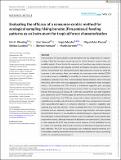Files in this item
Evaluating the efficacy of a consumer-centric method for ecological sampling : using bonobo (Pan paniscus) feeding patterns as an instrument for tropical forest characterization
Item metadata
| dc.contributor.author | Wessling, Erin G. | |
| dc.contributor.author | Samuni, Liran | |
| dc.contributor.author | Mundry, Roger | |
| dc.contributor.author | Pascual, Miguel Adan | |
| dc.contributor.author | Lucchesi, Stefano | |
| dc.contributor.author | Kambale, Bienfait | |
| dc.contributor.author | Surbeck, Martin | |
| dc.date.accessioned | 2023-01-05T10:30:52Z | |
| dc.date.available | 2023-01-05T10:30:52Z | |
| dc.date.issued | 2022-12-29 | |
| dc.identifier | 282814168 | |
| dc.identifier | e929fe90-92c7-4e32-9204-1902c15eb6d6 | |
| dc.identifier | 85145325274 | |
| dc.identifier | 000905691000001 | |
| dc.identifier.citation | Wessling , E G , Samuni , L , Mundry , R , Pascual , M A , Lucchesi , S , Kambale , B & Surbeck , M 2022 , ' Evaluating the efficacy of a consumer-centric method for ecological sampling : using bonobo ( Pan paniscus ) feeding patterns as an instrument for tropical forest characterization ' , Ecology and Evolution , vol. 12 , no. 12 , e9606 . https://doi.org/10.1002/ece3.9606 | en |
| dc.identifier.issn | 2045-7758 | |
| dc.identifier.other | RIS: urn:5EDED4CA0FE1DEA449A22A183BF7F8B7 | |
| dc.identifier.uri | https://hdl.handle.net/10023/26679 | |
| dc.description | Funding: This work was supported by Harvard University and the Max Planck Society. | en |
| dc.description.abstract | Characteristics of food availability and distribution are key components of a species' ecology. Objective ecological surveying used in animal behavior research does not consider aspects of selection by the consumer and therefore may produce imprecise measures of availability. We propose a method to integrate ecological sampling of an animal's environment into existing behavioral data collection systems by using the consumer as the surveyor. Here, we evaluate the consumer-centric method (CCM) of assessing resource availability for its ability to measure food resource abundance, distribution, and dispersion. This method catalogs feeding locations observed during behavioral observation and uses aggregated data to characterize these ecological metrics. We evaluated the CCM relative to traditional vegetation plot surveying using accumulated feeding locations across 3 years visited by a tropical frugivore, the bonobo (Pan paniscus), and compared it with data derived from over 200 vegetation plots across their 50 km2+ home ranges. We demonstrate that food species abundance estimates derived from the CCM are comparable to those derived from traditional vegetation plot sampling in less than 2 years of data collection, and agreement improved when accounting for aspects of consumer selectivity in objective vegetation plot sampling (e.g., tree size minima). Density correlated between CCM and plot-derived estimates and was relatively insensitive to home range inclusion and other species characteristics, however, it was sensitive to sampling frequency. Agreement between the methods in relative distribution of resources performed better across species than expected by chance, although measures of dispersion correlated poorly. Once tested in other systems, the CCM may provide a robust measure of food availability for use in relative food availability indices and can be incorporated into existing observational data collection. The CCM has an advantage over traditional sampling methods as it incorporates sampling biases relevant to the consumer, thereby serving as a promising method for animal behavioral research. | |
| dc.format.extent | 16 | |
| dc.format.extent | 2387721 | |
| dc.language.iso | eng | |
| dc.relation.ispartof | Ecology and Evolution | en |
| dc.subject | Dispersion | en |
| dc.subject | Distribution | en |
| dc.subject | Food availability | en |
| dc.subject | Resource selection | en |
| dc.subject | Species abundance | en |
| dc.subject | Vegetation plot | en |
| dc.subject | QL Zoology | en |
| dc.subject | NDAS | en |
| dc.subject | MCC | en |
| dc.subject.lcc | QL | en |
| dc.title | Evaluating the efficacy of a consumer-centric method for ecological sampling : using bonobo (Pan paniscus) feeding patterns as an instrument for tropical forest characterization | en |
| dc.type | Journal article | en |
| dc.contributor.institution | University of St Andrews. School of Psychology and Neuroscience | en |
| dc.identifier.doi | https://doi.org/10.1002/ece3.9606 | |
| dc.description.status | Peer reviewed | en |
This item appears in the following Collection(s)
Items in the St Andrews Research Repository are protected by copyright, with all rights reserved, unless otherwise indicated.

